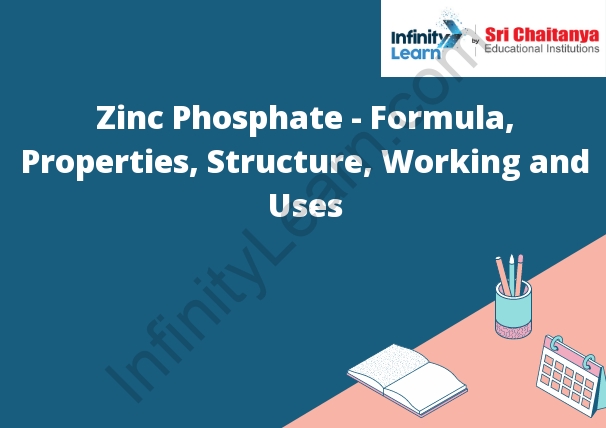Table of Contents
What is Zinc Phosphate?
Zinc phosphate is a compound of zinc and phosphorus. It has a white, powdery appearance and is used as a rust inhibitor and as a pigment in paints.

Zinc Phosphate Formula
Zinc phosphate is a white powder that is used as a food additive. It is a mineral that is used to improve the flavor and texture of food. It is also used as a preservative to prevent the growth of bacteria.
Zinc Phosphate properties
Zinc phosphate is a corrosion inhibitor that is effective in both acidic and alkaline environments. It is also a scale inhibitor, meaning that it prevents the formation of scale on surfaces. Zinc phosphate is insoluble in water and will not settle out, making it an effective dispersant. It also has a high boiling point, meaning that it will not evaporate easily.
Zinc Phosphate Structure – Zn3(PO4)2
Zinc phosphate is a white, insoluble powder that is the result of the reaction of zinc oxide and phosphoric acid. It is used as a corrosion inhibitor and a stabilizer in plastics.
How to Make Zinc Phosphate?
To make zinc phosphate, you will need zinc powder, phosphoric acid, and water.
1. Add the zinc powder to the water and stir until it is dissolved.
2. Add the phosphoric acid and stir until it is dissolved.
3. Pour the solution into a container and let it stand until it is solid.
4. Break up the solid and store it in a container.
Zinc Phosphate Coating
A phosphate coating is a type of conversion coating that is applied to ferrous metals to improve corrosion resistance. The phosphate coatings are usually applied by immersion in a vat of phosphoric acid.
Coating Process Using a Thermostatic Cell
The thermostatic cell is placed in the coating apparatus and the coating solution is heated to the desired temperature. The substrate to be coated is then placed in the thermostatic cell and the thermostatic cell is sealed. The substrate is then coated with the desired amount of the coating solution.
Working of Zinc Phosphate
The working of zinc phosphate is based on the principle that when two dissimilar metals are in contact, an electric current will flow between them. This current is called a galvanic current. The zinc phosphate will act as the anode and the iron will act as the cathode. The zinc phosphate will corrode and release hydrogen ions, which will then travel to the iron and cause it to corrode.
Symptoms when Exposed to Zinc Phosphide
Zinc phosphide is a colorless, odorless solid that rapidly becomes yellow on exposure to air. It is highly toxic, and exposure can cause symptoms such as chest pain, difficulty breathing, nausea, and vomiting.
Environmental Effects of Zinc Phosphate
Zinc phosphate is a type of zinc salt that is used as a corrosion inhibitor. It is also used as a pigment in paints and coatings. Zinc phosphate can be toxic to aquatic life, and it can also cause environmental damage.
Zinc Phosphate Uses
Zinc phosphate is a type of white, odorless powder that is used in a variety of industrial and commercial applications. It is a corrosion inhibitor, meaning that it helps to protect metal surfaces from corrosion. Zinc phosphate can also be used as a pigment in paints and coatings, and it is also a component of some types of concrete. In addition, it is used in the manufacture of some types of plastics.
Occurrence of Zinc phosphate
Zinc phosphate is a mineral that is found in rocks and soil. It is also found in human and animal tissues. Zinc phosphate is used in agriculture, animal feed, and food production. It is also used in making paints, plastics, and other products.








